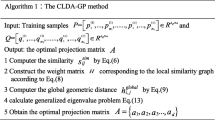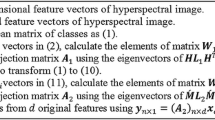Abstract
Stable orthogonal local discriminant embedding (SOLDE) is a recently proposed dimensionality reduction method, in which the similarity, diversity and interclass separability of the data samples are well utilized to obtain a set of orthogonal projection vectors. By combining multiple features of data, it outperforms many prevalent dimensionality reduction methods. However, the orthogonal projection vectors are obtained by a step-by-step procedure, which makes it computationally expensive. By generalizing the objective function of the SOLDE to a trace ratio problem, we propose a stable and orthogonal local discriminant embedding using trace ratio criterion (SOLDE-TR) for dimensionality reduction. An iterative procedure is provided to solve the trace ratio problem, due to which the SOLDE-TR method is always faster than the SOLDE. The projection vectors of the SOLDE-TR will always converge to a global solution, and the performances are always better than that of the SOLDE. Experimental results on two public image databases demonstrate the effectiveness and advantages of the proposed method.



Similar content being viewed by others
References
Belhumeur P N, Hespanha J P, Kriegman D J (1997) Eigenfaces vs. fisherfaces: recognition using class specific linear projection. IEEE Trans Pattern Anal Mach Intell 19(7):711–720
Benmokhtar R, Delhumeau J, Gosselin P H (2013) Efficient supervised dimensionality reduction for image categorization. In: Proceedings of the 2013 IEEE international conference on acoustics, speech and signal processing (ICASSP), pp 2425–2428
Boughnim N, Marot J, Fossati C, Bourennane S, Guerault F (2013) Fast and improved hand classification using dimensionality reduction and test set reduction. In: Proceedings of the 2013 IEEE international conference on acoustics, speech and signal processing (ICASSP), pp 1971–1975
Cai D, He X, Han J, Zhang H (2006) Orthogonal laplacianfaces for face recognition. IEEE Trans Image Process 15(11):3608–3614
Cai D, He X, Zhou K, Han J, Bao H (2007) Locality sensitive discriminant analysis. In: Proceedings of the 20th international joint conference on artificial intelligence, pp 708–713
Chang X, Ma Z, Yang Y, Zeng Z, Hauptmann AG (2016) Bi-level semantic representation analysis for multimedia event detection. IEEE Trans Cybern 1–18. doi:10.1109/TCYB.2016.2539546
Chang X, Nie F, Wang S, Yang Y, Zhou X, Zhang C (2016) Compound rank- k projections for bilinear analysis. IEEE Trans Neural Netw Learn Syst 27(7):1502–1513
Chang X, Yang Y (2016) Semisupervised feature analysis by mining correlations among multiple tasks. IEEE Trans Neural Netw Learn Syst 1–12. doi:10.1109/TNNLS.2016.2582746
Chang X, Yang Y, Long G, Zhang C, Hauptmann A G (2016) Dynamic concept composition for zero-example event detection. In: AAAI
Chang X, Yu YL, Yang Y, Xing EP (2016) Semantic pooling for complex event analysis in untrimmed videos. IEEE Trans Pattern Anal Mach Intell (99). doi:10.1109/TCYB.2015.2479645
Duchene J, Leclercq S (1988) An optimal transformation for discriminant and principal component analysis. IEEE Trans Pattern Anal Mach Intell 10(6):978–983
Gao Q, Ma J, Zhang H, Gao X, Liu Y (2013) Stable orthogonal local discriminant embedding for linear dimensionality reduction. IEEE Trans Image Process 22(7):2521–2531
Guo Y F, Li S J, Yang J Y, Shu T T, Wu L D (2003) A generalized foley–sammon transform based on generalized fisher discriminant criterion and its application to face recognition. Pattern Recogn Lett 24(1):147–158
He X, Yan S, Hu Y, Niyogi P, Zhang H (2005) Face recognition using laplacianfaces. IEEE Trans Pattern Anal Mach Intell 27(3):328–340
Jia Y, Nie F, Zhang C (2009) Trace ratio problem revisited. IEEE Trans Neural Netw 20(4):729–735
Li B N, Yu Q, Wang R, Xiang K, Wang M, Li X (2016) Block principal component analysis with nongreedy ℓ 1-norm maximization. IEEE Trans Cybern 46(11):2543–2547
Li H, Jiang T, Zhang K (2006) Efficient and robust feature extraction by maximum margin criterion. IEEE Trans Neural Netw 17(1):157–165
Luo M, Chang X, Nie L, Yang Y, Hauptmann AG, Zheng Q (2017) An adaptive semisupervised feature analysis for video semantic recognition. IEEE Trans Cybern. doi:10.1109/TCYB.2017.2647904
Parisotto E, Ghassabeh Y A, Freydoonnejad S, Rudzicz F (2015) Eeg dimensionality reduction in automatic identification of synonymy. In: 2015 IEEE international conference on acoustics, speech and signal processing (ICASSP), pp 847–851
Wang H, Lu X, Hu Z, Zheng W (2014) Fisher discriminant analysis with L1-norm. IEEE Trans Cybern 44(6):828–842
Wang H, Yan S, Xu D, Tang X, Huang T (2007) Trace ratio vs. ratio trace for dimensionality reduction. In: Proceedings of the 2007 IEEE conference on computer vision and pattern recognition, pp 1–8
Wang R, Nie F, Hong R, Chang X, Yang X, Yu W (2017) Fast and orthogonal locality preserving projections for dimensionality reduction. IEEE Trans Image Process PP(99):1–1. ISSN 1057-7149. doi:10.1109/TIP.2017.2726188
Wang S, Chen H, Peng X, Zhou C (2011) Exponential locality preserving projections for small sample size problem. Neurocomputing 74(17):3654–3662
Yan S, Xu D, Zhang B, Zhang H, Yang Q, Lin S (2007) Graph embedding and extensions: a general framework for dimensionality reduction. IEEE Trans Pattern Anal Mach Intell 29(1):40–51
Zhang T, Huang K, Li X, Yang J, Tao D (2010) Discriminative orthogonal neighborhood-preserving projections for classification. IEEE Trans Syst Man Cyberns Part B: Cybern 40(1):253–263
Zoidi O, Nikolaidis N, Pitas I (2014) Semi-supervised dimensionality reduction on data with multiple representations for label propagation on facial images. In: Proceedings of the 2014 IEEE international conference on acoustics, speech and signal processing (ICASSP), pp 6019–6023
Acknowledgements
This paper is supported by National Natural Science Foundation of China (No.61401471 and No.61501471); General Financial from the China Postdoctoral Science Foundation (No.2014M552589) and Special Financial from the China Postdoctoral Science Foundation (No.2015T81114).
Author information
Authors and Affiliations
Corresponding author
Rights and permissions
About this article
Cite this article
Yang, X., Liu, G., Yu, Q. et al. Stable and orthogonal local discriminant embedding using trace ratio criterion for dimensionality reduction. Multimed Tools Appl 77, 3071–3081 (2018). https://doi.org/10.1007/s11042-017-5022-1
Received:
Revised:
Accepted:
Published:
Issue Date:
DOI: https://doi.org/10.1007/s11042-017-5022-1




